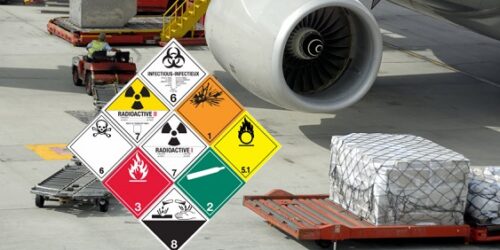CIFFA Exam Practice Questions & Answers – Export Packaging and Warehousing

CIFFA Exam Practice Questions & Answers – Export Packaging and Warehousing
- What are the two basic functions that packaging serves?
Marketing and distribution.
- What is palletizing or unitizing of cargo?
Assembling packages on a pallet base and securing the load to the pallet.
- What is the most common economical container/package?
Fibreboard box.
- What is the main problem with using wood packaging when shipping items internationally?
Wood packaging may contain pests which are harmful to the importing country, heat treatment is required (ISPM 15 compliance).
- Canadian warehouses operate under the laws of bailment. This means the warehouse operator is liable for damage or loss of goods arising out of his negligence.
- Name the three categories of warehouses.
Private, public and contract.
- Name three functions of a warehouse.
Inventory control; purchasing; order entry; receiving and inspection; redistribution; put-away; storage; replenishment; customer order selection checking; packing and marking; staging; consolidation and shipping; and clerical and administrative.
- Name three advantages of a private warehouse.
Control
Flexibility
Cost.
- Name five types of packages used in ocean freight shipments.
Fiberboard drums
Nailed wooden boxes
Crates
Wire bound boxes
Cleated plywood boxes
Cardboard (fiberboard) boxes
Steel drums
Barrels
Bales
- Describe the importance of marks and symbols.
They identify the shipment/packages and give any special instructions on the handling of the cargo.
- What are two standard sizes of North American pallets for ocean freight shipments?
40 in x 48 in, 40 in x 40 in, 48 in x 48 in.
- What details do you have to verify prior to stuffing an ocean container and an airfreight container?
Inspect the container to see if it’s watertight, check fittings/tie downs, cleanliness, check door locks and seal, and basic general condition.
- What points do you have to remember when loading an ocean and air freight container?
Observe weight limitations, avoid mixing incompatible cargo, observe hazardous material regulations, have all cargo and materials ready before beginning, plan for the loading and always remember that the unloading must be considered.
- What measures should be taken to prevent damage and losses?
Pack the goods properly, secure the cargo to prevent shifting, use proper dunnage and stowage materials. You should also place hazardous cargo near the door. Always pack for the toughest leg of the journey.
- Name at least three different types of public warehouses.
- General non-food warehouse
- Refrigerated warehouse
- Bonded warehouse
- Household goods warehouse
- Special commodity warehouse
- Dangerous goods warehouse
- Bulk storage warehouse
- What is a private warehouse? Describe.
It is owned by a company and operated by their own personnel. It is generally designed to meet the specific needs of the company. Provided the volume is large, it means lower cost.
- What are the advantages and disadvantages of using a public warehouse?
Advantages – no capital cost outlay, flexibility in required storage space.
Disadvantages – no control, communication is usually harder, the facility might not be geared to a company’s specific needs.
- What are the advantages and disadvantages of using a private warehouse?
Advantages – flexibility in the design, can meet specific needs, over a period of time it may become less costly than a public warehouse.
Disadvantages – capital outlay, costs, it is a fixed asset.
- What is the warehouseman’s liability?
Before a warehouse can be held liable, negligence must be proven. Normally the liability is 100 times one month’s storage charge.
- Describe a warehouse receipt and explain the difference between negotiable and non-negotiable receipt.
Acknowledgment on the part of the warehouse operator for the receipt of goods which are not his own and to place in storage in the warehouse.
Negotiable receipt – a document of title to the goods. The goods can only be released upon the surrender of the negotiable receipt, properly endorsed.
Non-negotiable receipt – a receipt for the goods, nothing else.
- Uniform palletized cargo in standard containers.
155 pallets of TV monitors, each pallet weighs 1,200 lb, the dimensions of each pallet are L48 in x W42 in x H34 in.
How many containers of which size are required for the total shipment? Work your answer out WITHOUT using a drawing. Stay within the container’s payload.
Solution:
The first thing we notice is that the length and width add up to 90 in. Remembering our “concept of 90”, we can calculate how many groups of 4 skids we can load on the floor of a 40- and 20-ft standard containers.
40-ft standard container:
On the floor of a 40-ft standard container:
474 : 90 = 5.26 or 5 groups of 4 = 20 pallets on the floor.
To determine how many we can stack, we divide the height of the container with the height of our skid. 90 : 34 = 2.6 or we can stack 2 pallets high.
We have also used up 450 in of floor length. 5 x 90 in = 450 in.
This leaves us 24 in at the door and we cannot load another pallet at the door.
Checking the weight, we find that:
40 x 1,200 lb = 48,000 lb = 21,773 kg, weight O.K.
We can safely load 40 pallets of TV monitors into a 40-ft container.
20-ft standard container:
On the floor of a 20-ft standard container:
232 : 90 = 2.6 or 2 groups of 4 = 8 pallets on the floor.
We already know that we can stack 2 high.
We have also used up 180 in of floor length. 2 x 90 in = 180 in.
This leaves us 232 in – 180 in = 52 in at the door. Can we load another pallet at the door? Easily!!
Checking the weight
20 x 1,200 lb = 24,000 lb = 10,886 kg. Weight is OK.
We can safely load 20 pallets of TV monitors into a 20-ft container.
40-ft high cube container:
We have already determined that we can load 20 pallets on the floor of a 40-ft container. How many can we stack in a 40-ft high cube container?
To determine how many we can stack, we divide the height of the container with the height of our skid. 102 : 34 = 3 or we can stack 3 pallets high.
Therefore, we can load 60 pallets into a 40-ft high cube container.
Checking the weight, we find that:
60 x 1,200 lb = 72,000 lb = 32,659 kg. Weight is NOT O.K.
We will concern ourselves with loading 20- and 40-ft standards.
As we have 155 pallets to ship, we take our 40 pallets and divide that into the number of pallets we have to ship.
155 : 40 = 3.875
As the result has a decimal place greater than 0.5 we are forced to “go to” another 40.
We will need 4 x 40-ft standard containers to ship the 155 pallets of TV monitors.
- Un-palletized cargo with single dimensions of cargo units in standard container.
10 Jeep Cherokees, each weighs 2,000 kg, the dimensions of each are L4.2 m (165 in) x W1.79 m (70 ½ in) x 1.61 m (63 in).
How many containers of which size are required?
We know that we can fit 2 Jeeps into a 40-ft standard container. 474 : 165 in = 2.87 (we cannot have 0.87 of a Jeep).
Take the number of Jeeps divided by the number we can load into a 40-ft standard container and this will give us our container requirements.
10 : 2 = 5 x 40-ft standard containers required.
Do not even consider a 45-ft container just because it allows loading 3 vehicles. A 45-ft high cube container is a specialized piece of equipment.
Not every carrier owns this type of equipment, and it is not allowed on every trade lane.
- Un-palletized cargo based on a reasonable average volume per container in standard containers. This applies when single dimensions of cargo units are not available.
500 cartons of tents, total weight is 12,500 kg, total volume is 100 m3.
How many standard containers of which size are required?
All the information given is just total volumes and weights. As the cargo is relatively light we do not have to worry about the weight.
We know that we can load 55 – 60 m3 of loose cargo into a 40-ft standard container. We would take our total volume and divide it by 55 m3, as a conservative estimate.
100 : by 55 m3 = 1.8 x 40-ft containers.
We cannot have 0.8 of a container, therefore we need 2 x 40-ft standard containers.
We can easily load all this cargo into 2 x 40-ft standard containers.
NOTE:
It is always a dangerous approach to calculate the total available m3 of inside airspace in a container and try to match this with your total cargo m3. This method might have tempted you to use just 1 x 40-ft HC plus 1 x 20 ft for the 100 m3 of tents. That would have been wrong and potentially embarrassing.
This question emphasises that in a real life situation you should insist with your client to supply you with actual carton dimensions if an accurate or binding stowage calculation is required.
But if you have to make an estimate, the relative estimated size of a carton would determine your estimate. The smaller the carton, the better the possibility to use the available space efficiently. If you have cartons of shoes, or other small sized cartons as you would have in a Far East import container, you probably can load a 40 ft to between 55 or 60 m3.
A tent is probably a mid-sized carton, therefore guessing you might load 50 m3 per 40 ft is a very reasonable guess, and the right answer. Any larger carton approaching the size of a pallet would cause more stowage space loss similar to palletized cargo.
- Open-top container for a special package in weight and dimensions.
One transformer consisting of main unit and 3 reels of cable.
Main Unit: Net measurement: L30 ft x W7 ft x H7 ft.
Weight: 22,000 lb.
Gross measurements if crated: L32 ft x W8 ft x H8 ft. Weight: 24,250 lb.
Reels: 4 ft diameter, width 2 ft.
Weight: each 1,100 lb.
- Can you load the “net” unit into an open-top container?
The un-crated transformer – the “net unit” can only fit into a 40-ft opentop container. The crated transformer has a width of 8 ft, which is the same as the outside width of 8 ft of any 40-ft standard or open-top container. Therefore, the “gross unit” (crated) cannot fit into a standard or open-top container.
- If yes, how? Through the door or the roof?
Loading must only be done through the uncovered top. You cannot load a unit of such length (30 ft) and weight (10 tons) through the door. Overhead cranes, either in house or rented, will be required to load this cargo. There is no forklift around capable of handling that length.
- Can you load the “gross” unit into an open-top container?
No!! As explained in answer a), the crated unit width is the same as the outside width of a container. Further, you should always check the roof opening with the carrier. The roof opening is generally 92 in wide.
- What is your comment in respect to the reels for loading with main unit into the same open-top container?
3 reels should be shipped separately as LCL cargo. The transformer must be centred in the container and blocked and braced at both ends, with some form of a small bulkhead at each end to prevent shifting. As a result, there will be no or limited space left for any additional cargo (reels).
- A mixed palletized cargo in a consolidation container.
Consignee container consolidation:
You are requested to load the following consolidation in Montréal into a container (all dimensions as LWH)
Ex Edmonton: 2 pallets of pressure gauges, each 48 in x 45 in x 44 in, 1,800 lb.
Ex Kitchener: 2 pallets of electric motors, each 45 in x 42 in x 42 in, 2,200 lb.
Ex Montréal: 2 pallets of filter sheets, each 42 in x 42 in x 42 in, 200 lb.
Ex Calgary: 2 pallets of assembly tools, each 46 in x 45 in x 42 in, 2,000 lb.
Ex Winnipeg: 2 pallets of fittings, each 44 in x 44 in x 40 in, 200 lb.
Ex Toronto: 1 crate of instrument panel, 8 ft x 5 ft x 6 ft, 1,150 lb.
- What size container is required for the complete shipment?
1 x 20- ft standard container.
- Try to show how you arrived at your answer without making a drawing.
Each of the two pallet lots has a width that allows the stowage/placement side by side. The heights are such that stacking of cargo can be accomplished easily. The only exception is the Toronto crate, which does not allow for either stowage of other freight beside it or on top of it.
To approach this problem you will gradually sum up the floor length used in the container as we “load” from the “nose” (front) to the door. You must remember, when we load cargo on top of other cargo, we do not use any additional floor length or space.
| Cargo Loaded | Floor Length Used | |
| 1. | Load Edmonton on floor at nose. 48 in x 45 in x 44 in; side by side. | 48 in |
| 2. | Load Kitchener on top of Edmonton. 45 in x 42 in x 42 in; side by side. No additional length used. | 48 in |
| 3. | Load Calgary on floor next. 46 in x 45 in x 42 in; side by side. We used an additional 46 in of floor length (48 in + 46 in = 94 in) | 94 in |
| 4. | Load Winnipeg on top of Calgary. 44 in x 44 in x 40 in; side by side. No additional length used. | 94 in |
| 5. | Load Toronto next on floor, 8 ft x 5 ft x 6 ft. We used an additional 8 ft (96 in) of floor length (94 in + 96 in = 190 in). | 190 in |
| 6. | Load Montréal on floor next, 42 in x 42 in x 42 in; side by side. 42 in of floor length is used (42 in + 190 in = 232 in). | 232 in |
| Total floor length used | 232 in |
The floor length used is that of a 20-ft container. We have been able to do a stowage plan and calculation without the need of a drawing.
Fortunately, all the pieces of the puzzle fit well. This is not always the case in your day-to-day operations. If you feel the need to do a “sketch”, then please do. It is not important as to how one determines a stowage plan, it is important that the result of the planning is correct.
- What is total cube in ft3? In m3?
| Origin | ft3 | m3 | Total Weight | |
| Ex Edmonton | 110 | 3.115 | 1,633 kg | |
| Ex Kitchener | 92 | 2.605 | 1,996 kg | |
| Ex Montréal | 86 | 2.436 | 181 kg | |
| Ex Calgary | 101 | 2.860 | 1,814 kg | |
| Ex Winnipeg | 90 | 2.549 | 181 kg | |
| Ex Toronto | 240 | 6.797 | 522 kg | |
| TOTALS | 719 | 20.362 | 6,327 kg |
We have also checked that the cargo weight is within the allowable load for a 20-ft standard container.
It is also advisable to make a chart similar to this when you are doing a first estimate to see what size of equipment you might need.
- What is the total length used inside the container?
As per answer b) we have used 232 in of floor space. The entire container length.





